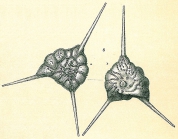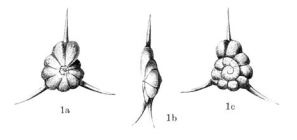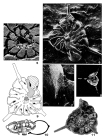WoRMS taxon details
Asterorotalia Hofker, 1950
112262 (urn:lsid:marinespecies.org:taxname:112262)
accepted
Genus
Rotalina (Calcarina) pulchella d'Orbigny, 1839 accepted as Calcarina pulchella (d'Orbigny, 1839) accepted as Rotalia pulchella (d'Orbigny, 1839) accepted as Asterorotalia pulchella (d'Orbigny, 1839) (type by monotypy)
Asiarotalia Nguyen Ngoc, 1986 · unaccepted > junior subjective synonym (Type species consistently...)
Type species consistently accepted under the genus Asterorotalia
- Species Asterorotalia concinna (Millett, 1904)
- Species Asterorotalia conica Shchedrina, 1984
- Species Asterorotalia dentata (Parker & Jones, 1865)
- Species Asterorotalia milletti Billman, Hottinger & Oesterle, 1980
- Species Asterorotalia multispinosa (Nakamura, 1937)
- Species Asterorotalia penangensis McCulloch, 1977
- Species Asterorotalia pulchella (d'Orbigny, 1839)
- Species Asterorotalia subtrispinosa (Ishizaki, 1941)
- Species Asterorotalia gaimardi (d'Orbigny in Fornasini, 1906) accepted as Rotalinoides gaimardi (d'Orbigny in Fornasini, 1906) (Type species of Rotalinoides)
- Species Asterorotalia gaimardii (d'Orbigny in Fornasini, 1906) accepted as Rotalinoides gaimardi (d'Orbigny in Fornasini, 1906) (Incorrect subsequent spelling in Billman et al. (1980) & Genus transfer)
- Species Asterorotalia inflata (Millett, 1904) accepted as Asterorotalia milletti Billman, Hottinger & Oesterle, 1980
- Species Asterorotalia rolshauseni (Cushman & Bermúdez, 1946) accepted as Ammonia rolshauseni (Cushman & Bermúdez, 1946)
- Species Asterorotalia trispinosa (Thalmann, 1933) accepted as Asterorotalia pulchella (d'Orbigny, 1839) (subjective junior synonym in opinion of Le Calvez, 1977)
marine, fresh, terrestrial
feminine
Hofker, J. (1950). Wonderful animals of the sea: Foraminifera. <em>The Amsterdam Naturalist.</em> vol. 1 nº 3, 60–79, 42 text-figs.
page(s): p. 73, 76 [details]
page(s): p. 73, 76 [details]
Hayward, B.W.; Le Coze, F.; Vachard, D.; Gross, O. (2024). World Foraminifera Database. Asterorotalia Hofker, 1950. Accessed through: World Register of Marine Species at: https://www.marinespecies.org/aphia.php?p=taxdetails&id=112262 on 2024-07-11
Date
action
by
![]() The webpage text is licensed under a Creative Commons Attribution 4.0 License
The webpage text is licensed under a Creative Commons Attribution 4.0 License
original description
Hofker, J. (1950). Wonderful animals of the sea: Foraminifera. <em>The Amsterdam Naturalist.</em> vol. 1 nº 3, 60–79, 42 text-figs.
page(s): p. 73, 76 [details]
original description (of Asiarotalia Nguyen Ngoc, 1986) Nguyen Ngoc. (1986). Asiarotalia - A new genus of Foraminifera from later Kainozoic sediments of the Mekong plain. <em>Journal of Earth Sciences.</em> 5: 19-22. [details] Available for editors [request]
[request]
basis of record Gross, O. (2001). Foraminifera, <B><I>in</I></B>: Costello, M.J. <i>et al.</i> (Ed.) (2001). <i>European register of marine species: a check-list of the marine species in Europe and a bibliography of guides to their identification. Collection Patrimoines Naturels,</i> 50: pp. 60-75 (look up in IMIS) [details]
additional source Loeblich, A. R.; Tappan, H. (1987). Foraminiferal Genera and their Classification. Van Nostrand Reinhold Company, New York. 970pp., available online at https://books.google.pt/books?id=n_BqCQAAQBAJ [details] Available for editors [request]
[request]
page(s): p. 73, 76 [details]
original description (of Asiarotalia Nguyen Ngoc, 1986) Nguyen Ngoc. (1986). Asiarotalia - A new genus of Foraminifera from later Kainozoic sediments of the Mekong plain. <em>Journal of Earth Sciences.</em> 5: 19-22. [details] Available for editors
basis of record Gross, O. (2001). Foraminifera, <B><I>in</I></B>: Costello, M.J. <i>et al.</i> (Ed.) (2001). <i>European register of marine species: a check-list of the marine species in Europe and a bibliography of guides to their identification. Collection Patrimoines Naturels,</i> 50: pp. 60-75 (look up in IMIS) [details]
additional source Loeblich, A. R.; Tappan, H. (1987). Foraminiferal Genera and their Classification. Van Nostrand Reinhold Company, New York. 970pp., available online at https://books.google.pt/books?id=n_BqCQAAQBAJ [details] Available for editors
From editor or global species database
Diagnosis Test flattened, low trochospiral to nearly planispiral coil of two to three whorls, eight to twelve chambers in the final whorl, sutures slightly depressed, chambers on umbilical side separated by deeply incised sutures with granulose to spinose borders, the umbilical end of the wide sutural interlocular space covered by a backward extension from the lip of the final chamber, liplike extensions of successive chambers radiating from the umbilicus that is filled with a central pillar, simple spiral canal around the umbilical plug is connected to the hooked umbilical extensions from the chambers, periphery with imperforate keel interrupted by deep sutural incisions; wall calcareous, perforate, optically radial, surface of spiral side smooth between the numerous inflational knobs, pustules, and ridges that may obscure the sutures or the sutural incisions may be bordered by narrow ridges, three large solid spines arise as extensions from the imperforate keel of the first whorl in megalospheric specimens and from the third whorl of the microspheric generation and are subsequently enlarged by lamellar growth as new chambers and whorls are added; aperture a vertically aligned and nearly equatorial ovate opening at the base of the apertural face, a small hooked foraminal plate present at the umbilical margin of the foramen. Pliocene to Holocene; Caribbean: Cuba; Indonesia: Borneo, Java; Persian Gulf. (Loeblich & Tappan, 1987, Foraminiferal Genera and Their Classification) [details]





